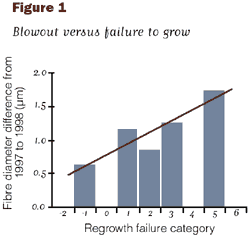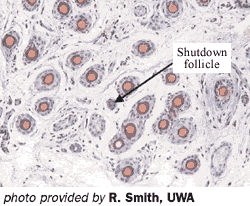
Loss of hair fibres from human scalp in genetically-predisposed males (common male pattern baldness) is a phenomenon well known to all of us. Researchers in Western Australia now believe that the Australian Merino sheep suffers a similar fate.
Dr Tony Schlink of CSIRO Animal Production explains: “Researchers in Western Australia and South Australia had noted, contrary to the popularly held belief that Merino sheep do not shed their fibres, that at certain times of the year some of the follicles in Merino sheep cease fibre production. This is particularly the case at the ‘break of the season’ in Mediterranean environments.”
They also showed that those sheep with a tendency to shed fibres produced weaker staples. “We were interested in studying this phenomenon of follicle shutdown because it has important implications not only to staple strength, but also to total fleece production. If follicles stop producing a fibre then clearly this will affect total fleece production, particularly if the fibres are shed from the fleece,” Dr Schlink said.
To find out if shed fibres are indeed lost from the fleece, Dr Schlink’s team used an ingenious method for ensuring all fibres stayed within the fleece. They coated the staples of Merino weaners with silicon glue and then compared the incidence of shed fibres within the fleeces of glued versus non-glued staple patches. “We showed that the number of shed fibre ends in glued and non-glued areas was similar, indicating that the fibres are in fact retained within the fleece.”
Follicles that stopped producing a fibre did not all start producing a fibre again (similar to male pattern baldness!). “The importance of this finding,” says Dr Schlink, “is that there was a close relationship between the failure to regrow fibres, and the change in fibre diameter at the next shearing.” In other words those sheep whose follicles did not reactivate after shutdown, tended to ‘blowout’ in fibre diameter (Figure 1).


Ongoing work will examine the effects of supplementation on the rates of fibre shedding and fibre regrowth, and to determine whether or not there are strain differences in the tendency to shut follicles down and regrow fibres.
In this issue of The Wool Press: